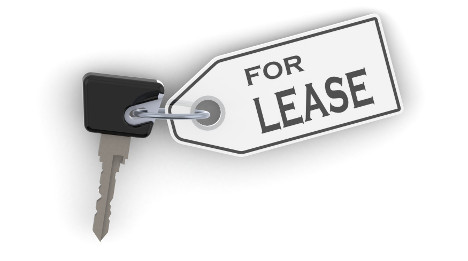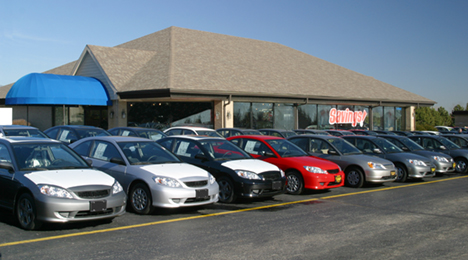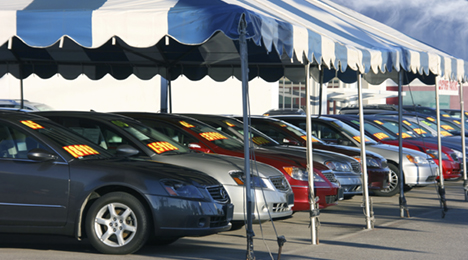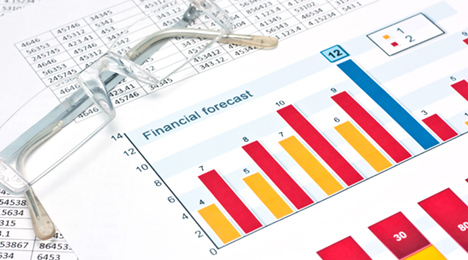More off-lease and off-rental volumes hit the physical auction and online upstream remarketing channels in July, according to the latest recap of wholesale market trends from ADESA’s Tom Kontos.
This helped foster greater used supply in the market, one of the factors leading to softer overall wholesale values (compared to June).
As far as pricing within these consignment segments, he spotted a few varying movements in the latest Kontos Kommentary report.
“Prices for used vehicles remarketed by manufacturers were down 1.9 percent month-over-month and down 4.7 percent year-over-year, indicating weaker demand for high off-rental program vehicle inventories,” said Kontos, the chief economist for ADESA Analytical Services.
“Prices for fleet/lease consignors were down 0.9 percent sequentially but up 2.2 percent annually, though prices for off-rental ‘risk’ units within this segment were down significantly,” he added.
Trends within these slices of the remarketing business will be covered in detail as part of the Sept. 1 print and digital editions of Auto Remarketing, which is our special look at Top Fleet, Lease & Rental Trends.
For more on wholesale pricing movements, see Auto Remarketing’s complete recap of Kontos’ analysis here.
While beating year-ago numbers, used vehicles didn’t fetch as much money in the wholesale market during July as they did in June.
And while the year-over-year decline in July’s retail used-car sales played a role in pushing down these wholesale prices, another factor affecting used values appears to a positive for dealers.
In his latest monthly report to explain wholesale price changes, ADESA Analytical Services chief economist Tom Kontos said that there was an increase in the number off-lease and off-rental units flowing into upstream and physical auction channels.
That, plus additional trade-ins sparked by strong new-car sales, led to a boost in supply. And that’s not all, Kontos said.
“Growing auction inventories are also exerting downward pressure on wholesale prices,” he said in the Kontos Kommentary report released this week.
All told, July wholesale prices came in at an average of $9,743, according to the analysis from ADESA Analytical Services. This marked a 2.2-percent decrease from June and a 3.3-percent rise from July 2013.
All but one segment — mid/full-size CUVs, whose prices were static — saw a month-over-month decrease in wholesale values.
“Minivans and mini SUVs were particularly hard-hit, with month-over-month price declines of 5.7 percent and 3.8 percent, respectively,” Kontos said in the report.
Year-over-year, however, 12 of the 15 segments in ADESA’s analysis showed price growth. The largest was for full-size vans (up 16.3 percent), followed by full-size pickups (up 9.4 percent) and midsize SUVs (up 9.1 percent). The three decliners were compact CUVs (down 3.0 percent), mid/full-size CUVs (down 3.3 percent) and sporty cars (down 1.1 percent).
By segment group, car prices were up 1.6 percent year-over-year and down 2.9 percent month-over-month; truck prices jumped 9.3 percent from July 2013 and fell 1.8 percent from June; crossover prices fell 3.1 percent year-over-year and dropped 1.4 percent month-over-month.
Kontos delved into auction price trends among seller types, as well, and detailed the implications of those movements for the remarketing business.
“Prices for used vehicles remarketed by manufacturers were down 1.9 percent month-over-month and down 4.7 percent year-over-year, indicating weaker demand for high off-rental program vehicle inventories,” he said.
“Prices for fleet/lease consignors were down 0.9 percent sequentially but up 2.2 percent annually, though prices for off-rental ‘risk’ units within this segment were down significantly,” Kontos continued. “Dealer consignors saw a 2.9-percent average price decrease versus June, and their prices were flat relative to July 2013.”
Halfway through 2014, year-to-date auction volume was up nearly 4 percent against comparable weeks of 2013, according to the National Auto Auction Association.
In its latest Economic Dashboard, which is prepared by NAAA economist Ira Silver, the association indicates that auction volume in June was up 3.9 percent year-over-year (for comparable weeks), and through the first six months of the year, it has increased 3.8 percent.
With these types of gains in the amount of inventory flowing through the auction and other channels, dealers, it seems, are able to get their hands are more used cars for their lots, Auto Remarketing reported in its Power 300 Issue.
In fact, used days’ supply was projected to climb 2.4 percent in June, according to that month’s Retail Automotive Summary from CNW Research.
The late-model side of the market has been particularly fortunate when it comes to additional supply, NADA Used Car Guide said in a recent report.
Citing NADA’s used-vehicle supply forecast, the NADA Perspective report from May called for 8-percent growth in late-model supply this year, topped off with 9-percent growth next year.
NADA said that “combined, the 17-percent increase in used supply through 2015 will act as an additional catalyst supporting a continued increase in CPO sales.”
This monthly report from NADA Used Car Guide hammered home how the late-model supply that feeds certified pre-owned programs and CPO retail demand have been simultaneously growing in recent years – and this has been and will continue to be strong for certified sales.
“The sharp increase in CPO demand that has occurred over the past two years has come at an opportune time for manufacturers,” NADA UCG said.
“After years of declines stemming from the falloff in new-vehicle sales during the recession, late-model supply — or the primary pool from which CPO vehicles are derived — finally started growing again in 2013,” NADA added.
Interestingly, the growth in supply of CPO-friendly cars that began in 2013 occurred right after the certified market had just recorded two straight best-ever years.
With more bountiful supply of late-model units in 2013, the industry reached yet another record year for certified sales and appears headed that way again in 2014.
Jonathan Banks, NADA’s senior director of vehicle analysis and analytics, alluded to this growth during a press conference at January’s NADA Convention & Expo, when he said the record sum from 2013 would likely be “blown away” by what happens in 2014.
“The big story here is, there will be more availability for the franchised dealers for inventory for those CPO units, which is great for consumers and great for dealers,” Banks said during the press conference.
“We think that 2.1 million CPO sales (figure) … will be blown away, driven by the availability of lease returns that will inevitably come back in 2014,” he said.
And that could be quite a few.
During this a July conference call to discuss Manheim Used Vehicle Value Index movement for the second quarter, Manheim chief economist Tom Webb discussed the fleet and lease vehicles that were bought up three to four years ago and are now heading into the auction lanes.
While off-lease volume grew at a steady pace at auction so far in 2014, Manheim expects this rate to pick up even more during the second half of the year.
“They (off-lease volumes) are continuing to grow — we expected the increases in the back half of this year would be more than the first half, and that is the case,” said Webb. “Certainly the off-lease volume is tracking along with expectations. The percentage of those that end up in a traditional auction process is pretty much in line with expectations, as well.”
Webb pointed out that since residual values are very strong, a large percentage of these off-lease vehicles are still being bought by franchised dealers as well as lessees.
But, that said, the tides are turning.
“A greater number of off-lease units are getting into the auction environment — and not only that, the open auction environment, as well,” said Webb.
He pointed out that lease returns are growing at such a volume that the lessors and the franchised dealer network “cannot absorb” them all, pushing many units into the auction lanes.
And Webb said, “Bigger growth is yet to come.”
For more Power features and to check out the 2014 Auto Remarketing Power 300 Issue, click here.
Expanding used supply means lower pre-owned prices — but analysts say trends on the new-car side of the market will serve to push used rates down every further.
Analysts at ALG and RVI both cited new-car sales as a factor that will lower used prices in the coming years.
According to ALG, this trend has reappeared for the first time since 2008.
ALG analysts say a “wave” of newer vehicles from trade-ins has started to flood the secondhand market and will gradually bring resale values back down to pre-recession levels.
“The continued strength of new-car sales is increasing the availability of high-quality used cars as shoppers continue to trade in their old vehicles,” said Larry Dominique, president of ALG and executive vice president at TrueCar. “Additionally, because of the popularity of short 24- and 36-month leases, the drought of used-car supply is already starting to subside. As a result, we expect a steady decline in used-vehicle prices.”
And RVI analysts said in the latest Risk Outlook report that as new-car competition increases and new-car prices decline — pushing many used customers to the new market — this trend will also play a part in pushing used prices down even further, as well.
Residuals are also expected to have an impact on used-car prices.
According to ALG, by 2017 the average new vehicle will retain 49.4 percent of its value after three years, compared to the 54.6-percent retention recorded for vehicles through June 2014.
Used units will follow suit as ALG predicts growing supply will put the residual average back at 46 percent — the pre-recession rate — by 2019.
“The lower residual values will create a greater gulf between used- and new-vehicle prices, which could steer more consumers to purchase used vehicles,” said Dominique. “Consequently, we expect automakers to increase new-car incentives to keep up their current sales pace.”
ALG is predicting used prices will fall by 5.2 percent by 2017. Over at RVI, the company expects nominal used prices to drop by 10 percent by 2017.
For more on used price movement, see the following Auto Remarketing story:
Used Prices Expected to Fall by 10% by 2019
The potential risk to used-car values from increases in off-lease volume and lease penetration rates is something that Alec Gutierrez is keeping a close watch on.
The KBB senior analyst doesn’t see much of a dust-up yet, but there could be potential for gradual “downward pressure” on used values a couple years down the road.
However, one benefit from these upward leasing movements has been the impact on certified pre-owned, Gutierrez said during a conference call with the media on Friday, speaking to reporters along with AutoTrader.com senior analyst Michelle Krebs.
“I think that is part of what’s been driving the strength in the certified pre-owned market,” he said. “There’s a much higher availability of these 1- to 3-year-old off-lease units, which dealers have luckily found there’s been plenty of consumer demand to scoop up.”
Or, as Krebs put it: “There’s been this incredible hunger for good used cars, because we didn’t sell many new cars during the recessionary years.”
She continued: “There has been a dearth – of course, the prices have been higher, the mileage is high. There is this hunger in the market for newer used cars, these off-lease types of cars.”
That has been evident on the consumer-side with CPO sales this year, including July numbers for various brands that began to trickle in on Friday.
Hyundai, for example, had its best-ever month for certified sales, moving 8,490 CPO units.
This was a 26.1-percent year-over-year increase and pushed the year-to-date sum to 54,342 CPO sales (up 23.1 percent).
Volkswagen also had its best July ever for certified sales, despite year-to-date numbers being 8.6 percent lower. VW moved 8,126 CPO units for the month, compared to 8,114 certified sales a year ago.
At Mazda, its certified numbers for July came in 12 percent higher at 3,637 sales. Through seven months, it has moved 24,289 CPO rides for a 15-percent increase.
Audi, meanwhile, increased its CPO sales from 3,252 units in July 2013 to 4,116 in the most recently completed month. Year-to-date certified sales (25,943) are also beating year-ago numbers (22,437) for Audi.
There were 9,114 Mercedes-Benz certified pre-owned sales for the month, a 14.3-percent increase. Through seven months, there have been 66,686 CPO sales, a 17-percent hike.
The CPO programs at Ford moved a grand total of 23,000 units in July and have sold 154,957 cars year-to-date. For Lincoln, it was 2,213 certified sales in July and 14,575 sales throughout seven months.
There were 20,787 Ford/Lincoln CPO sales in July, and there have been 140,382 sales year-to-date.
In July sales conference call notes posted to Toyota’s U.S. media site, company executives estimated the Toyota brand’s CPO sales at 31,000 units for the month and the Lexus brand’s CPO sales at 6,000 units.
At BMW Group, there were 16,884 sales of BMW used vehicles, a tally that includes CPO and pre-owned units and marks a 12.6-percent year-over-year increase. Through July, there have been 114,823 sales for a 13.1-percent hike.
As for the group's MINI brand, it had its best July on record for used sales (again, including CPO and pre-owned) with 2,115 units sold (up 7.1 percent).
Yearly sales stand at 14,454 units (up 17.5 percent).
Analysts are predicting a larger flow of off-lease vehicles in the second half of the year to push down auction prices, but in June and for the whole first half of 2014, wholesale prices remained strong.
According to the latest NADA Guidelines report, consumer demand for used and new cars was high last month, leaving NADA’s seasonally adjusted used-vehicle price index consistent with May results.
Though used prices normally begin dropping in June as the industry approaches the summer slowdown, the index sat at 126.4 for the month, down a slight 0.1 percent from May’s record high of 126.5.
NADA UCG senior director of vehicle analysis and analytics Jonathan Banks did point out, though, the prices of used vehicles up to 8 years old fell by 2.4 percent compared to May.
“Depreciation across segments followed a familiar pattern as of late, where declines for subcompact and mid-size cars overshadowed the overall market average, while losses for large pickups and SUVs were below the industry mean,” Banks stated, illustrating the rate of decline among the segments NADA tracks.
Subcompact and midsize cars saw prices fall the most last month on the non-luxury side of the market, with prices for the two collectively falling by 3.1 percent.
This continued a trend of heavy price dips for these segments. Banks pointed out over the last three months, prices for these two car segments have dropped by an average of 6.7 percent, which equates to almost as much as the two saw prices rise during the first quarter.
Luxury vehicles also experienced a big hit this past month. Luxury midsize and luxury large cars saw prices fall in June by 3.5 percent and 3.2 percent, respectively.
On the other hand, large pickups and SUVs continued to out-perform the industry, with a combined average decline of slightly over 1 percent, Banks reported.
In a recent video interview, Black Book editorial director Ricky Beggs asked ADESA chief economist Tom Kontos for his take on why truck prices have experienced such strong price retention.
Kontos cited a few factors, such as more younger, lower mileage trucks flowing into the lanes, as well as construction rates, and more.
For more analysis from Kontos on auction price trends, see the following Auto Remarketing story:
Video: Kontos Talks Used Supply, Truck Strength & Recon
Where Prices Are Headed This Month
Banks pointed out NADA’s predictions for July and August when it comes to where auction prices are headed have changed slightly from the June edition of Guidelines.
NADA expects wholesale prices to fall by a slower rate of approximately 1 percent in July. Once again, the trucks are expected to see stronger price retention than cars, “especially on luxury models,” said Banks.
Car prices are expected to fall by over the 1 percent industry average, while large pickups and SUVs will most likely see prices remain flat-to-up slightly, according to the report.
That said, as we head closer to fall, depreciation is expected to pick up.
“Per the seasonal norm, depreciation is forecast to pick up to a range of 1.5-2 percent in August before increasing to an average of roughly 2.5 percent in September,” Banks stated.
A Strong First Half
Overall, wholesale prices for the first half of the year were much higher than the same period of 2013, Banks pointed out.
Consequently, auction prices are up 2.8 percent higher than seen during the same period last year.
Breaking the numbers down by segment, prices for large pickups are up almost 12 percent. Offering a comparison, prices for smaller cars “haven’t performed nearly as well,” said Banks.
For example subcompacts are down by 1.6 percent compared to last year.
The luxury car segment has also taken a hit, as prices are down 5.1 percent for luxury large cars.
Banks reported this drop is the largest out of any segment so far this year.
And though prices remain up for the year, analysts are predicting an influx of off-lease vehicles flowing into the lanes will put downward pressure on prices in the lanes during the second half.
Manheim chief economist Tom Webb said in a recent conference call that although off-lease volume grew at a steady pace at auction so far in 2014, Manheim expects this rate to pick up even more during the second half of the year.
“They (off-lease volumes) are continuing to grow — we expected the increases in the back half of this year would be more than the first half, and that is the case,” said Webb, chief economist at Manheim Consulting. “Certainly the off-lease volume is tracking along with expectations. The percentage of those that end up in a traditional auction process is pretty much in line with expectations, as well.”
For more on predicted off-lease trends for the second half of the year, see the following Auto Remarketing story:
Off-Lease Volume to Get Boost in Second Half
With increases in the amount of inventory flowing through the auction and other channels, dealers, it seems, are able to get their hands on an ample supply of used cars for their lots.
Halfway through 2014, year-to-date auction volume is up nearly 4 percent against comparable weeks of 2013, according to the National Auto Auction Association.
In its latest Economic Dashboard, which is prepared by NAAA economist Ira Silver, the association indicates that auction volume in June was up 3.9 percent year-over-year (for comparable weeks), and through the first six months of the year, it has increased 3.8 percent.
According to CNW Research, used-car supply (measured as available inventory to sell at retail) was at 45.49 days in June. And while this was down 1.49 percent year-over-year, it hovers near what CNW considers to be an ideal level of 45 days’ supply.
By vehicle type, there were 47.11 days’ supply of used cars last month, versus 43.28 days’ worth of used truck supply, CNW indicated.
Breaking that down further, franchised dealers had 47.78 days’ supply of used vehicles in June, while independents were at 45.28.
Month-by-Month Trending
CNW also provided data on how used days’ supply has ebbed and flowed each month of 2014. So far, inventory levels have stayed between 45 and 52 days’ supply in each of the first six months.
The only year-over-year rise was a 1.36-percent increase in February. But it should be noted that inventory either rose or remained flat in each of the first six months of 2013, including double-digital-percentage increases in January, February and March of last year — and days’ supply for all three of those months was over 50.
Below is how days’ supply has shaken out in the first six months of 2014, per CNW, with year-over-year change in parentheses:
January: 49.72 (down 0.80%)
February: 51.33 (up 1.36%)
March: 47.96 (down 6.31%)
April: 48.27 (down 3.13%
May: 46.13 (down 1.41%)
June: 45.49 (down 1.49%)
There is the expectation out there that off-lease volume is set to spike in the second half of the year, and Tom Kontos echoes that sentiment.
In an interview with Black Book editorial director Ricky Beggs, Kontos — the chief economist at ADESA — talked on key aspects of the wholesale industry such as retail demand, off-lease supply, the certififed pre-owned business and more.
Kontos began by noting the softening of auction prices that analysts have long predicted is on its way.
“When we started seeing the uptick in new-car sales near the end of the recession and there was an uptick in leasing, as well, we knew there would be an uptick in off-lease volume at this time,” he said. “So we are starting to see the impact of that. As economists would always say, if you have got more supply, but the same level of demand out there, the only thing to adjust would be prices.”
We are beginning to see the “softening cycle” in wholesale values, Kontos said, which is largely due to incoming supply.
And the push-down is expected to speed up in the second half of the year.
“I think we will see that impact develop more strongly in the second half, resulting in further softening of used-car prices,” Kontos said.
But one factor has kept prices relatively stable so far this year: consumer demand.
And Kontos pointed out one niche market — CPO — is pushing this trend.
“Thus far, what has helped a lot has been the sheer level of retail demand, specifically for CPO vehicles. That has been a really hot area in the market, and that’s supported used-car values. It has extended the length of higher wholesale values a bit longer than I would have predicted,” Kontos said.
“It is a compatible product with the new and used-car business, and it helps in brand establishment for manufacturers. It’s a 'good guy' for the business,” he continued.
It is also good for wholesalers and consignors, as the CPO business has supported used-car values as of late.
The Tides Are Turning for Trucks
Trucks have experienced stronger price retention so far this year, but Beggs and Kontos discussed how the tides may turn as supply expands.
Recent turmoil in Eastern Europe and the Middle East have caused crude oil prices to rise as of late, but diesel fuel prices have remained relatively stable.
Beggs pointed out this trend has potentially increased demand for heavy trucks.
Another factor that is pushing prices higher for the truck segments is an influx of younger, lower-mileage trucks in the lanes.
Kontos said, “Some people have been saying that its (strong truck prices) been due to more of the younger 2012 model-year used trucks coming into the market, and that is inflating the average values of used trucks.”
High construction rates has also spurred demand for these work-ready vehicles.
That said, Kontos explained prices will eventually turn down, similar to trends seen in the car segments this year.
“There is a recovery in supply on the truck side … in that there is a greater availability of those used trucks — this will push prices down in the long run, but now it is actually helping prices because the dealers really need those cars, and independent truckers really need those trucks, as well,” Kontos explained.
In fact, prices for trucks have already started falling for auctions in the Northeast of the country, where Kontos said there is rapidly expanding supply.
“The Northeast has been an area where there is a high concentration of off-lease volumes, but at the same time, that was the part of the country that was impacted the most by weather,” Kontos said. “So that double whammy caused a greater amount of over-supply right now on the ground of used trucks coming out of off-lease and the rental fleets.
“You see softer prices for trucks in that region than in the rest of the country,” Kontos added.
ADESA is working to push some of that over supply into areas with higher demand and lower supply, which could potentially positively impact prices.
The company is also working to sell vehicles online and give the responsibility of moving the vehicle to the buyer.
“Opening it up to a broader geography online, you can alleviate some of the regional differences in price — we are trying to advise our customers to consider those upstream channels, as well as moving the vehicles,” Kontos said.
A Focus on Recon
Lastly, Beggs wrapped the interview up by asking Kontos for one piece of advice for those in the industry as they look forward to the second half of the year.
Kontos had one word: reconditioning.
He explained quality reconditioning benefits everyone in the business — buyer and consignor.
“Traditionally, I have been an advocate of reconditioning, and it’s not simply because that’s an area we generate some revenue in, but because it’s a win-win for the consignor and the buyer. If you buy a vehicle that is more retail ready, you can get it on the front line and retail it quicker,” Kontos said.
“So, strategically a little more recon in a more challenging pricing environment going forward is probably a good piece of advice,” he concluded.
To view the complete interview, see the above video.
After reporting that consumer demand is driving wholesale prices up, Manheim’s Tom Webb covered one player that could potentially reverse this price trend in the future: off-lease and off-rental vehicles.
During this week’s conference call to discuss Manheim Used Vehicle Value Index movement for the second quarter, Webb touched on a topic many dealers and industry followers are following closely: the expected influx of off-lease vehicles stemming from the pickup in leasing which began back in 2010 and 2011.
Now, those fleet and lease vehicles that were bought up three to four years ago are heading into the lanes.
And Webb said though off-lease volume grew at a steady pace at auction so far in 2014, Manheim expects this rate to pick up even more during the second half of the year.
“They (off-lease volumes) are continuing to grow — we expected the increases in the back half of this year would be more than the first half, and that is the case,” said Webb, chief economist at Manheim Consulting. “Certainly the off-lease volume is tracking along with expectations. The percentage of those that end up in a traditional auction process is pretty much in line with expectations, as well.”
Webb pointed out that since residual values are very strong, a large percentage of these off-lease vehicles are still being bought by franchised dealers as well as lessees.
But, that said, the tides are turning.
“A greater number of off-lease units are getting into the auction environment — and not only that, the open auction environment, as well,” said Webb.
He pointed out that lease returns are growing at such a volume that the lessors and the franchised dealer network “cannot absorb” them all, pushing many units into the auction lanes.
And Webb said, “Bigger growth is yet to come.”
As for how this volume growth will impact used prices, the prediction for cheaper auction units comes with a caveat.
“The volumes are certainly going to grow, and at an increasing rate, so you would expect that would put downward pressure on prices,” said Webb. “The offset again is that tremendous strength in retail demand is keeping prices up.”
In fact, consumer demand is what played a part in pushing used prices up in the second quarter.
Attractive financing has put car purchases within more consumers’ grasp, said Manheim, and this change was illustrated in the 1-percent spike in the Manheim Used Vehicle Value Index in the second quarter versus Q1 rates.
Newer Models in the Lanes
Webb pointed out one other trend to keep an eye on, as well, as more off-lease vehicles enter the lanes.
When leasing fell off after the recession, the auction lanes were primarily stocked with older mileage vehicles, many of which were dealer trade-ins that stores were having trouble retailing.
This put pressure on prices, as well as dealers trying to stock their lots with quality, used inventory.
Now, as leasing has picked up and the first big batch of off-rental and off-lease rides since the recession is starting to flow into the industry, Webb pointed out the amount of lower mileage, 3-year-old inventory at auction will spike — but it may be a slow process.
“It (ratio of high mileage, older vehicles to younger, low-mileage vehicles) is starting to shift back, but it is shifting very slowly,” said Webb.
“You see 3-year, prior-model-year, off-lease volumes are picking up,” he added.
That said, dealer consignment volumes have continued to grow this year also, Webb said, which is still keeping the auction lanes stocked with older, higher-mileage vehicles, as well.
A trend among rental companies may have contributed to an older stock of vehicles at auction during the first half of the year, as well.
“A couple of the (rental) companies did keep vehicles in service longer this year because they had a need for them,” Webb said.
This caused many vehicles that normally would have hit the lanes in March to come back in May; and this extension equated to slightly higher vehicle mileage in Q1 and Q2.
But these trends are temporary, as Webb predicts the volume of younger, lower-mileage vehicles at auction to continue to grow.
Webb said, “It (volume of lower mileage, younger vehicles at auction) won’t go back to levels seen before the recession, but it will trend back quite a bit.”
As the weather heated up in May, demand for sporty cars for the summer months spiked, contributing to a scarcity issue for some models.
The Porsche Cayman, in particular, was difficult to find for dealers.
That’s according to May’s installment of vehicle scarcity data that is provided monthly to Auto Remarketing from AutoTrader.com.
The Cayman took the top spot nationally for both scarcest CPO and used vehicle in May.
The CPO model also took the top spot in Philadelphia, moving up seven spots since April. The sporty CPO ride came in at No 2. in Los Angeles, where it was not even on the list in the month prior.
The used model also landed at No. 1 in the San Francisco-Oakland-San Jose designated market area, which is the same spot it held in April.
The Porsche Boxster was also hard to find as spring wrapped up. The CPO model came in at No. 4 nationally, and it was not on the list the prior month.
It also appeared in three DMAs, landing at No. 2 in Philadelphia, No. 4 in Los Angeles and No. 10 in New York.
The used Boxster also landed on the national scarcity list, AutoTrader.com analysts pointed out, coming in at No. 7, up one spot from April.
It also appeared on the lists in three DMAs, coming in at No. 1 in San Francisco-Oakland-San Jose, No. 7 in Chicago and No. 8 in Houston.
The Chevrolet Corvette was another model in high demand in May and the third high-end model to make both the national CPO and used scarcity lists.
The CPO model came in at No. 5 nationally, and the used model came in at No. 8 nationally.
The CPO model also had notable scarcity across several DMAs, including Dallas-Ft. Worth, Philadelphia, Washington, D.C., Chicago and Houston.
“As a sign that summer is here, the Porsche Cayman, Porsche Boxster and Chevrolet Corvette are luring more online shoppers. The strength of Porsche continues with strong demand for the beautifully styled Cayman and the competitively priced Boxster,” said Juan Flores, director of operations for AutoTrader.com’s Trade-In Marketplace. “With the redesigned Stingray putting Corvette back into the spotlight in recent months, pre-owned Corvettes are experiencing a halo effect of the hype and excitement around the new model.”
As construction rates move on at a consistent pace, big trucks were in high demand in May, as well.
Interestingly, Flores pointed out demand is high, but there is a catch: low supply.
“The challenge for the full-size truck segment is not due to lack of consumer interest, but more-so for lack of inventory in the metro markets. What’s interesting and significant is that heavy duty trucks have made our scarcity list,” said Flores. “This is clearly a sign that validates higher resale values for the ever important full-size truck segment.”
Here’s how the scarcity lists broke down for these models:
- The CPO Ford F-350 came in at No. 6 in Philadelphia, up one spot from April.
- The CPO Ford F-250 came in at No. 7 in Los Angeles and No. 8 in Washington, D.C.; it was not on the list in either of those DMAs in April.
- The Used Ford F-250 came in at No. 10 in San Francisco-Oakland-San Jose. It was not on the list in that DMA in April.
- The CPO GMC Canyon came in at No. 10 in Philadelphia. It was not on the list in that DMA in April.
- The Used GMC Sierra 3500 came in at No. 5 in New York. It was not on the list in that DMA in April.
- The Used Ram 2500 came in at No. 6 in Boston, up three spots since April.
- The CPO Ram 1500 came in at No. 9 in San Francisco-Oakland-San Jose. It was not on the list in that DMA in April.
- The CPO Chevrolet Colorado came in at No. 8 in Chicago. It was not on the list in that DMA in April.
Click below to view the complete scarcity charts for May from AutoTrader.com:














